VCSA 6.X(VMware vCenter Server Appliance)空间不足问题处理 2021-12-18 虚拟化 暂无评论 5277 次阅读 黑色数据网络实验室 2019年10月 VMware推荐部署使用Linux版本的vCenter Server,VCSA在企业生产环境中已经大量使用,特别是提供从Windows版本迁移到Linux版本工具后,VCSA的使用达到了一个新的高度。 随着使用时间的增加,不少管理人员发现问题,VCSA虚拟机运行越来越慢,部分甚至直接挂死,或者虚拟机启动后服务无法启动,最常见的是下列的报错提示: 报错提示一 ``` 503 Service Unavailable (Failed to connect to endpoint: [[N7Vmacore4Http16LocalServiceSpecE:0x00005649e04415e0] _serverNamespace = / _isRedirect = false _pipeName =/var/run/vmware/vpxd-webserver-pipe) ``` 报错提示二 ``` 503 Service Unavailable (Failed to connect to endpoint: [N7Vmacore4Http16LocalServiceSpecE:0x00005649e04415e0] _serverNamespace = /ui action = Allow _port = 5090) ``` 报错提示三 ``` HTTP Status 404 – Not Found Type Status Report Message ProxyServlet: /ui/ Description The origin server did not find a current representation for the target resource or is not willing to disclose that one exists. ``` 实际上导致这些问题的发生多数情况是由于磁盘空间不足问题导致,VCSA使用SUSE Linux系统,一些熟悉Linux的管理人员就直接动手删除VCSA虚拟机的部分文件来增加使用空间,切记切记:不要用传统Linux思维来管理VCSA,直接删除文件可能导致VCSA完全无法使用。比如删除了部分日志,但VCSA的一些日志删除后系统无法重建,而这些日志文件如果被删除就会导致VCSA服务无法启动。 正确的处理方式是对VMDK进行扩容操作,VCSA 6.0 中引入逻辑卷管理 (LVM) ,VCSA 6.5和6.7都能够很好的支持,动态增VCSA磁盘空间。 VCSA 6.X虚拟机磁盘空间最容易不足的就是/storage/log(对应VMDK 5)/storage/db(对应VMDK 6),/storage/dblog(对应VMDK 7),再次提醒:不要直接删除日志文件。 正确处理方式: 1、新建一台VCSA 6.7进行操作,其他6.X 版本基本相同。 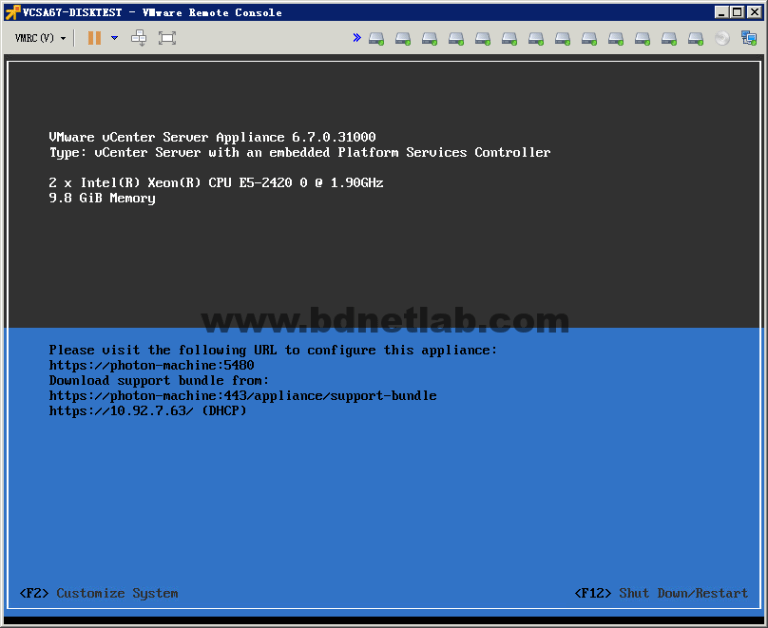 2、查看VCSA 6.7虚拟机虚拟机VMDK信息,6.7版本一共使用13个VMDK,各VMDK解释参考表一、表二、表三解释。 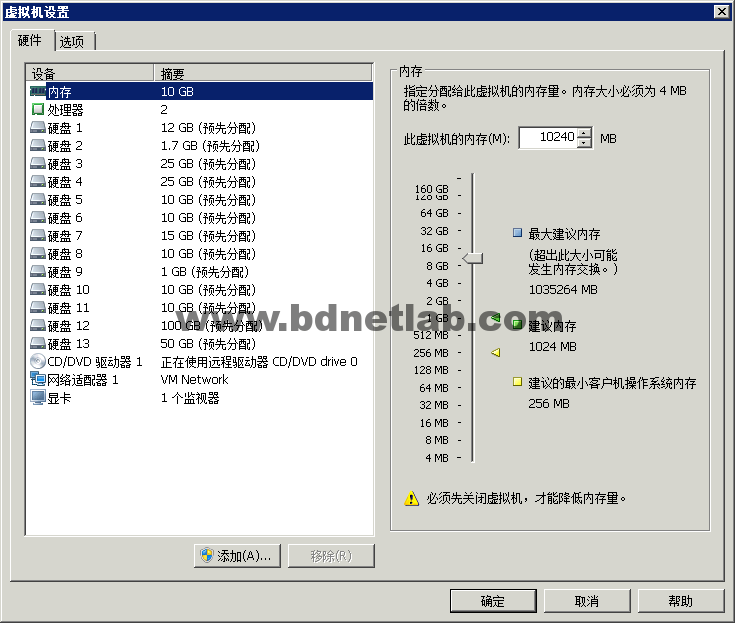 表一 VCSA 6.0版本使用11个VMDK |VMDK|默认大小|挂载点|解释| |:----:|:----:|:----:|:----:| |VMDK1|12 GB| / (10 GB) /boot (132 MB) SWAP (1 GB)|存储着内核映像和引导加载配置的引导目录| |VMDK2|1.3 GB|/tmp|临时目录,用于存储生成的临时文件或供 vCenter Server 中的服务使用| |VMDK3|25 GB|SWAP|交换目录,系统内存不足时使用此目录交换到磁盘| |VMDK4|25 GB|/storage/core|核心目录,存储 vCenter Server 中 VPXD 进程的核心转储| |VMDK5|10 GB|/storage/log|日志目录,vCenter Server 在此目录中存储环境的所有日志| |VMDK6|10 GB|/storage/db|VMware Postgres 数据库存储位置| |VMDK7|5 GB|/storage/dblog|VMware Postgres 数据库日志记录位置| |VMDK8|10 GB|/storage/seat|VMware Postgres 的状态、事件、告警和任务 (SEAT) 目录| |VMDK9|1 GB|/storage/netdump|VMware Netdump Collector 存储库,用于存储 ESXi 转储| |VMDK10|10 GB|/storage/autodeploy|VMware Auto Deploy 存储库,存储用于 ESXi 主机无状态引导的 thinpackage| |VMDK11|5 GB|/storage/invsvc|VMware Inventory Service 目录,xDB、Inventory Service 引导程序配置文件和 tomcat 配置文件位于此目录中| 表二 VCSA 6.5版本使用12个VMDK |VMDK|默认大小|挂载点|解释| |:----:|:----:|:----:|:----:| |VMDK1|12GB|/ (10GB) /boot (132MB) SWAP (1GB)|内核映像和引导加载程序配置的存储目录。| |VMDK2|1.8GB|/tmp|用于存储vCenter Server服务生成或使用的临时文件的目录| |VMDK3|25GB|SWAP|系统内存不足以交换到磁盘时使用的目录| |VMDK4|25GB|/storage/core|存储来自vCenter Server的VPXD 进程的核心转储的目录| |VMDK5|10GB|/storage/log|vCenter Server和Platform Services Controller存储环境所有日志的目录| |VMDK6|10GB|/storage/db|VMware Postgres数据库存储位置| |VMDK7|5GB|/storage/dblog|VMware Postgres数据库日志记录位置| |VMDK8|10GB|/storage/seat|VMware Postgres的统计,事件,警报和任务(SEAT)目录| |VMDK9|1GB|/storage/netdump|存储ESXi转储的VMware Netdump收集器存储库| |VMDK10|10GB|/storage/autodeploy|VMware Auto Deploy存储库,该存储库存储用于无状态启动ESXi主机的瘦程序包| |VMDK11|10GB|/storage/imagebuilder|VMware Image Builder存储库,用于存储vSphere映像配置文件,软件仓库和VIB软件包,例如驱动程序VIB和更新VIB。| |VMDK12|100GB|/storage/updatemgr|VMware Update Manager存储库,用于存储虚拟机和ESXi主机的修补程序和更新| 表三 VCSA 6.0版本使用13个VMDK |VMDK|默认大小|挂载点|解释| |:----:|:----:|:----:|:----:| |VMDK1|12GB|/ (10GB) /boot (132MB) SWAP (1GB)|内核映像和引导加载程序配置的存储目录。| |VMDK2|1.8GB|/tmp|用于存储vCenter Server服务生成或使用的临时文件的目录| |VMDK3|25GB|SWAP|系统内存不足以交换到磁盘时使用的目录| |VMDK4|25GB|/storage/core|存储来自vCenter Server的VPXD 进程的核心转储的目录| |VMDK5|10GB|/storage/log|vCenter Server和Platform Services Controller存储环境所有日志的目录| |VMDK6|10GB|/storage/db|VMware Postgres数据库存储位置| |VMDK7|5GB|/storage/dblog|VMware Postgres数据库日志记录位置| |VMDK8|10GB|/storage/seat|VMware Postgres的统计,事件,警报和任务(SEAT)目录| |VMDK9|1GB|/storage/netdump|存储ESXi转储的VMware Netdump收集器存储库| |VMDK10|10GB|/storage/autodeploy|VMware Auto Deploy存储库,该存储库存储用于无状态启动ESXi主机的瘦程序包| |VMDK11|10GB|/storage/imagebuilder|VMware Image Builder存储库,用于存储vSphere映像配置文件,软件仓库和VIB软件包,例如驱动程序VIB和更新VIB。| |VMDK12|100GB|/storage/updatemgr|VMware Update Manager存储库,用于存储虚拟机和ESXi主机的修补程序和更新| |VMDK13|50GB|/storage/archive|VMware Postgres数据库的预写日志(WAL)位置| 第3步,登录VCSA 6.7虚拟机,使用命令df -Th查看空间大小。 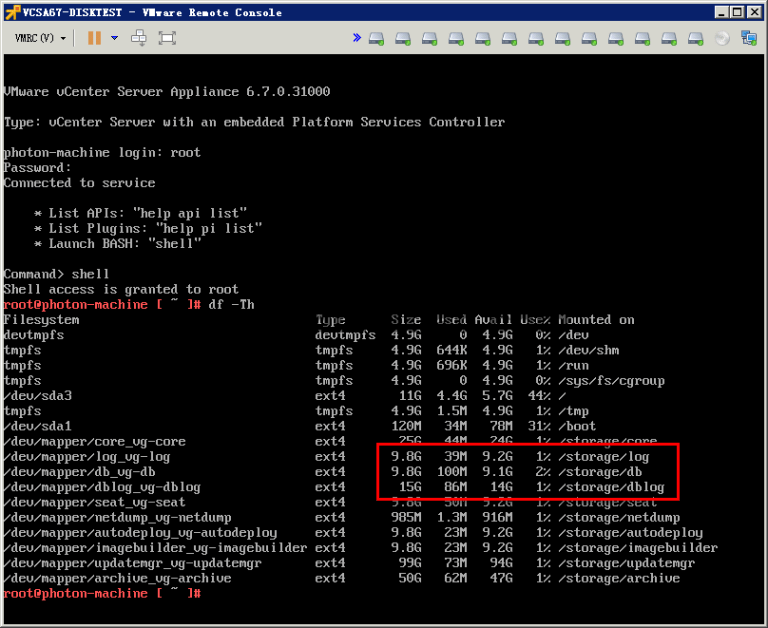 第4步,查看对应VMDK容量信息。 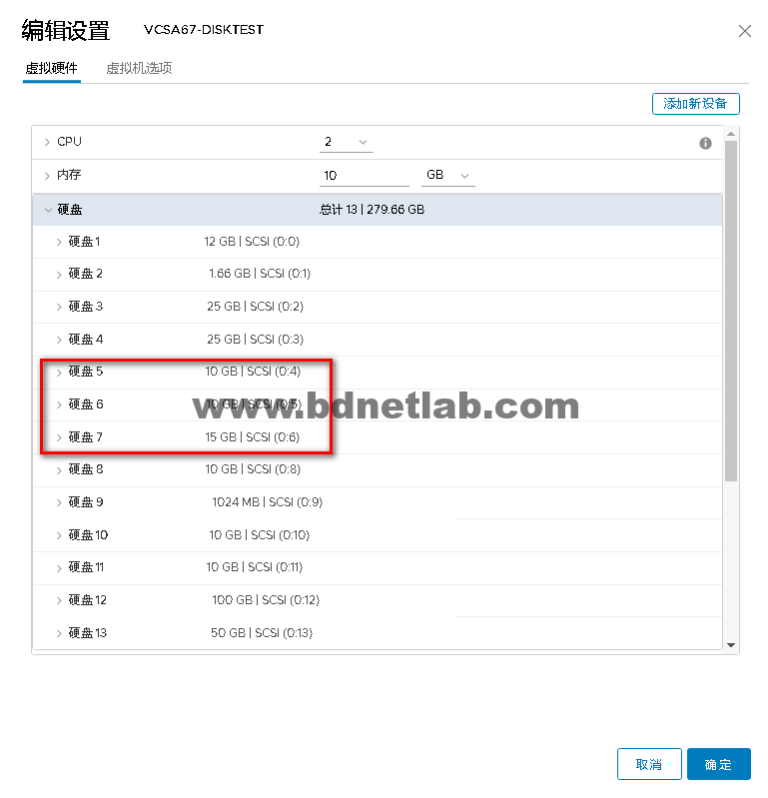 第5步,增加VMDK容量,每个增加10G空间。 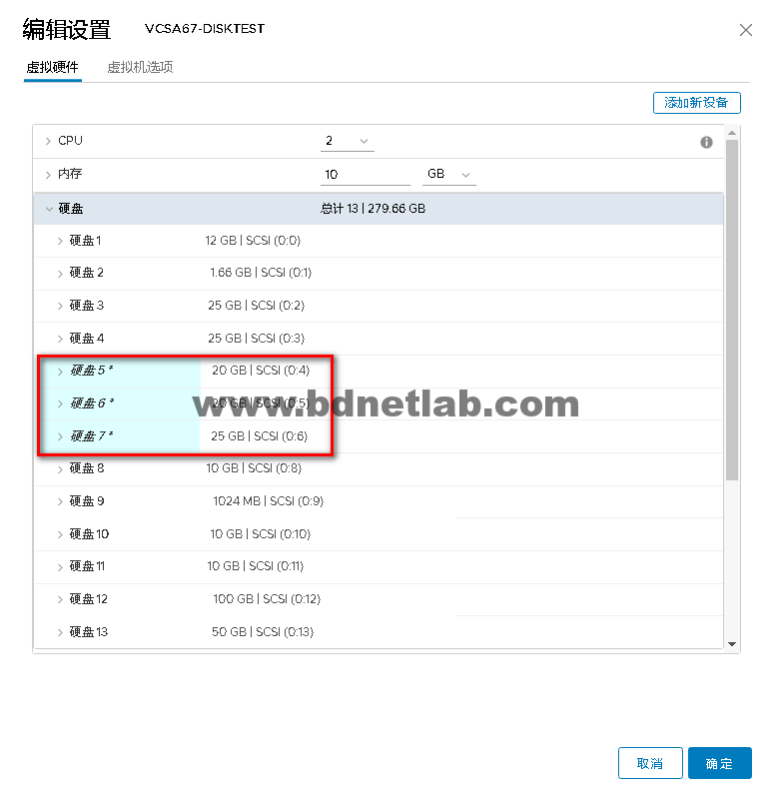 第6步,增加虚拟磁盘空间后,直接使用命令自动展开所有增加了物理卷的逻辑卷vpxd_servicecfg storage lvm autogrow没有错,就是一条命令 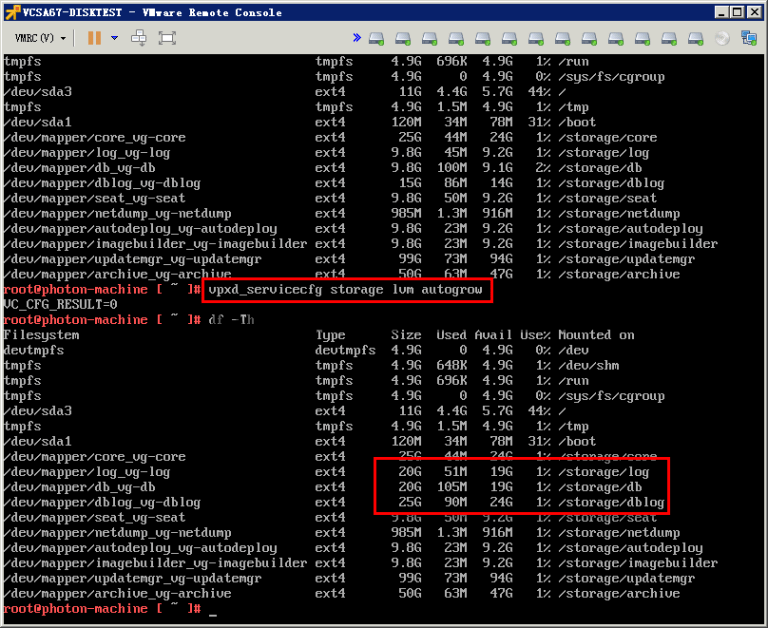 第7步,扩容成功。 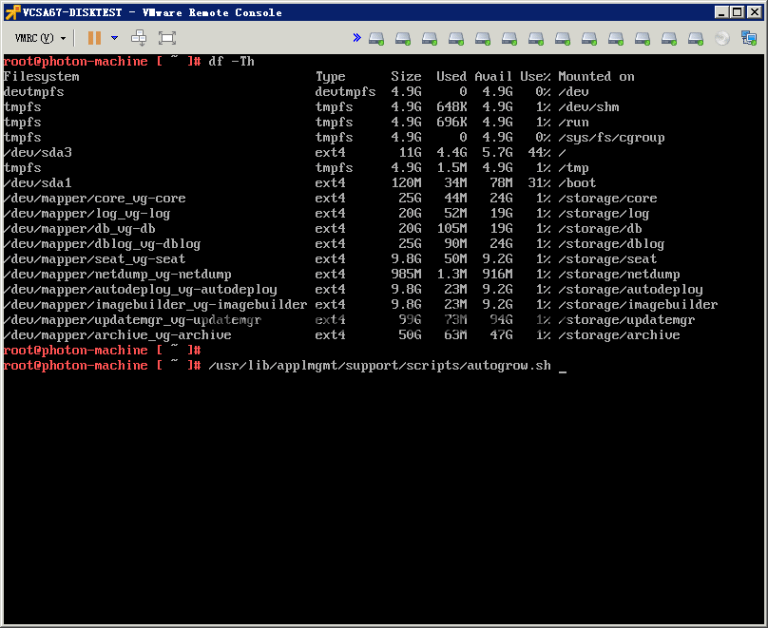 第8步,使用命令/usr/lib/applmgmt/support/scripts/autogrow.sh也可以进行扩容。 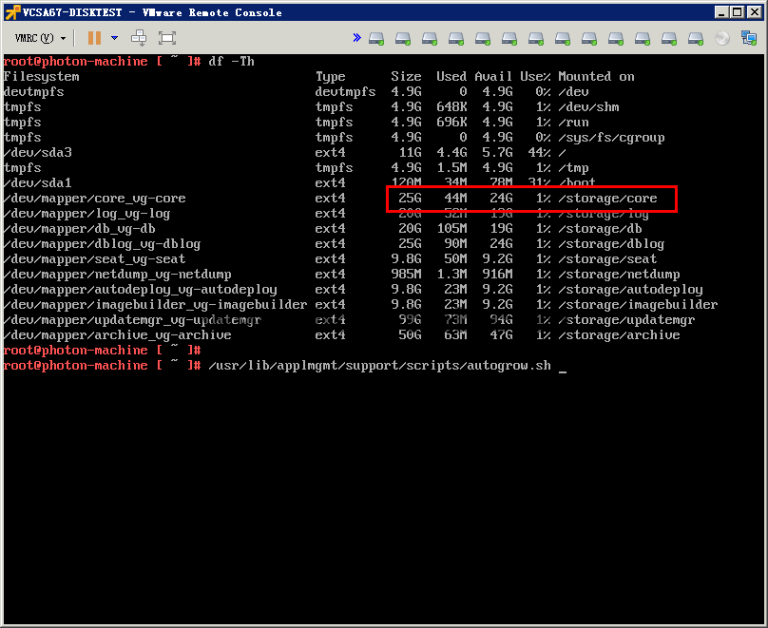 第9步,增加50G后的效果。 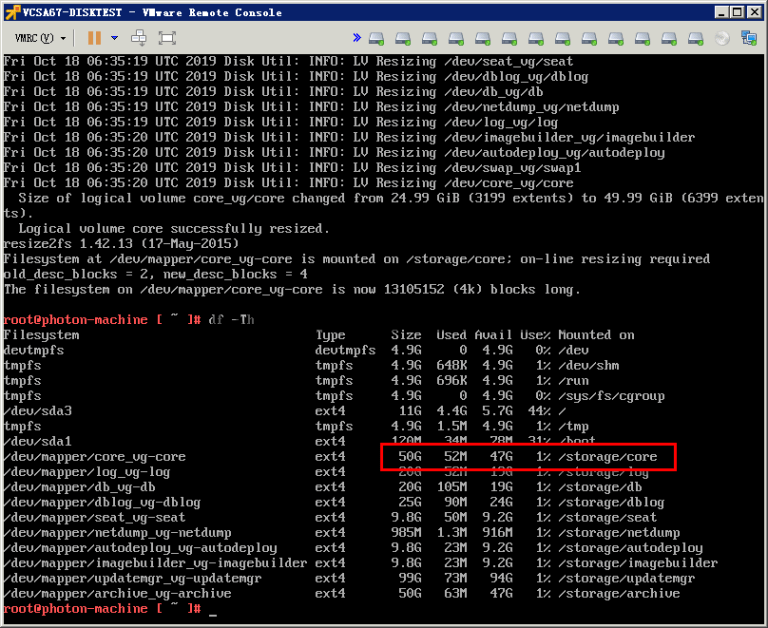 第10步,使用命令启动服务,所有服务全部正常启动。 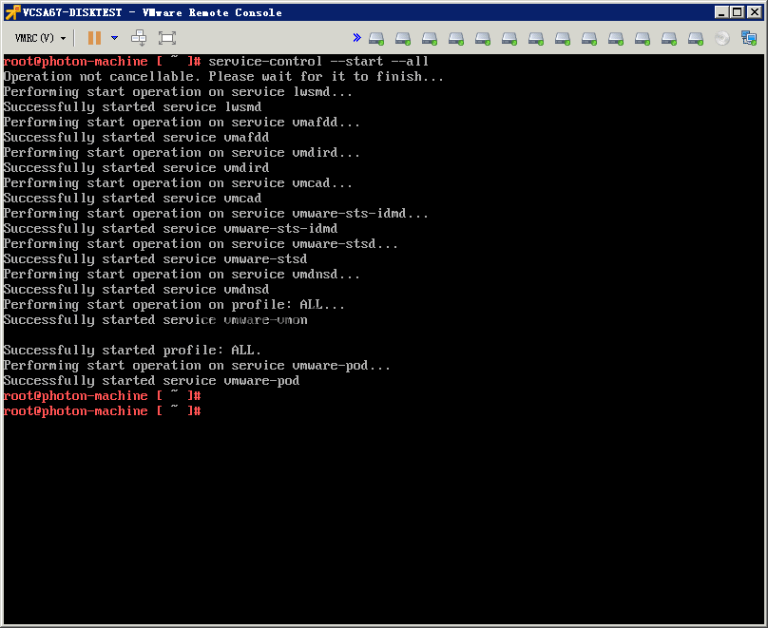 第11步,使用浏览器访问VCSA 6.7,恢复正常。 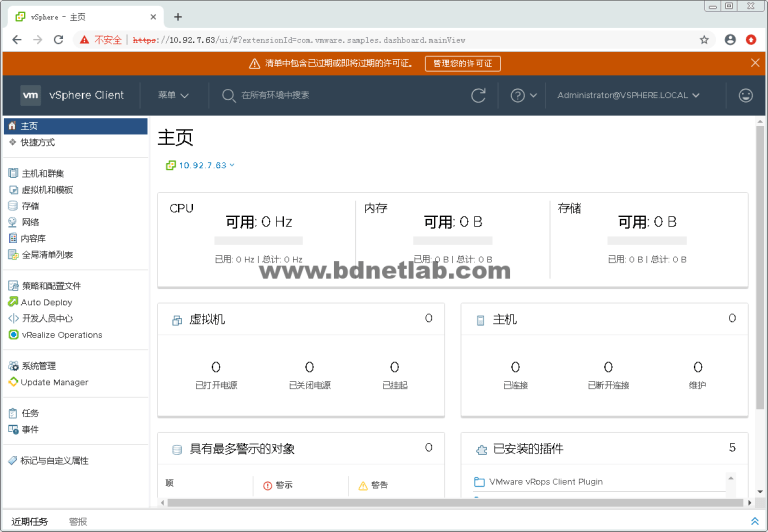 最后再提醒:不要用传统Linux思维来管理VCSA,直接删除文件可能导致VCSA完全无法使用。 转自http://www.bdnetlab.com/?p=1356 标签: vcsa 本作品采用 知识共享署名-相同方式共享 4.0 国际许可协议 进行许可。